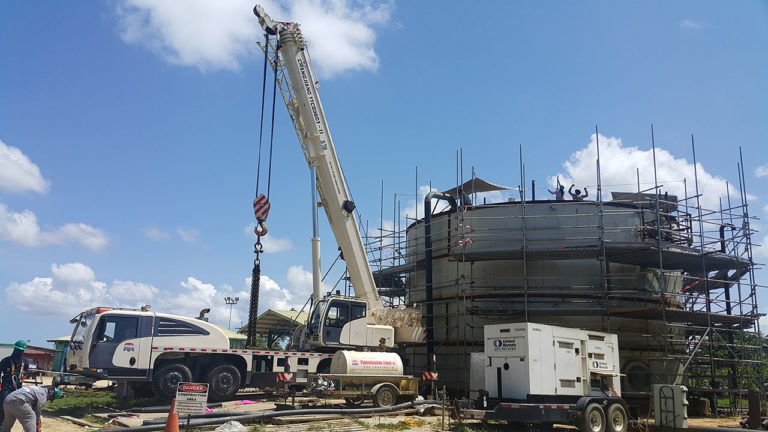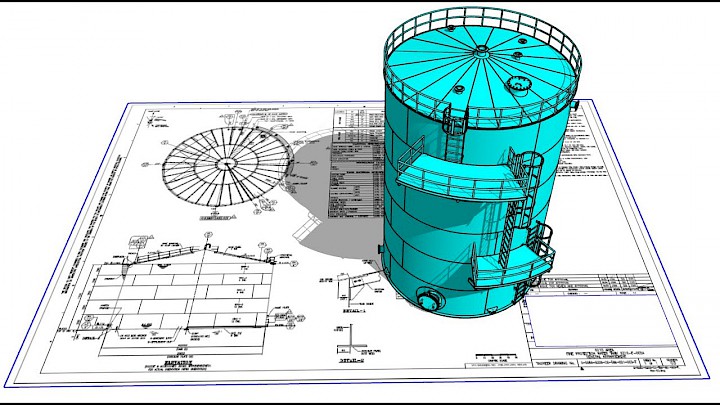A Step-by-Step Check Out the Installation Refine of Welding Inspection Techniques
Welding examination is an essential process that assures structural honesty and security. The installation of assessment techniques includes numerous organized steps, each essential to accomplishing dependable results. From planning and tool choice to conducting non-destructive and aesthetic tests, each phase needs cautious focus. Understanding these procedures can substantially improve quality control in welding jobs. What obstacles arise in carrying out these techniques, and exactly how can they be properly addressed?
Understanding the Value of Welding Inspection
Welding evaluation is a vital element of ensuring structural integrity and security in building and manufacturing procedures. This practice entails reviewing bonded joints for defects, making certain that they meet particular criteria and laws. By systematically gauging weld quality, examiners can recognize concerns such as fractures, spaces, and insufficient combination, which can endanger the toughness and durability of structures.
The significance of welding examination prolongs past prompt safety and security worries; it helps stop expensive failures and potential threats in the long-term. Effective inspection techniques foster conformity with market requirements, consequently improving the overall reliability of bonded components. Additionally, a robust examination procedure contributes to maintaining the credibility of building contractors and makers, as it assures customers of the high quality of their jobs. Ultimately, understanding the relevance of welding evaluation is crucial for advertising risk-free building techniques and making sure the longevity of essential framework and products.
Picking the Right Equipment for Inspection
When choosing the proper tools for inspection, it is vital to contemplate the particular requirements of the welding process and the materials entailed. Various evaluation techniques, such as visual, ultrasonic, and radiographic testing, require distinctive devices tailored to their distinct needs. For aesthetic inspections, devices like magnifying glasses and calipers are essential for evaluating weld high quality. Ultrasonic screening calls for specialized devices with the ability of sending and obtaining sound waves to find inner flaws. Radiographic testing, on the other hand, makes use of X-ray or gamma-ray resources alongside sensitive movie or electronic detectors to reveal variances.
Furthermore, individual safety devices (PPE) is crucial to guarantee the safety of inspectors during evaluations. Selecting the right tools not only enhances the accuracy of inspections but likewise adds to the general stability and safety and security of the welding project. As a result, a detailed understanding of readily available devices and their applications is critical for effective welding evaluation.
Planning for the Examination Process
Before launching the assessment procedure, it is necessary to develop an extensive strategy that details the scope and objectives of the examination. This strategy ought to consist of certain requirements that specify what makes up acceptable top quality in the welding work being evaluated. Identifying the pertinent codes and requirements is vital, as they will certainly direct the evaluation requirements and methodologies.
Furthermore, personnel associated with the inspection should be properly educated and certified in welding assessment techniques to guarantee integrity and accuracy. A list can be advantageous in arranging the different aspects of the examination, ranging from devices preparedness to ecological problems that might influence the assessment.

Logistical factors to consider such as organizing, readily available sources, and interaction between group members should be addressed. By preparing systematically, examiners can boost the performance of the evaluation and ensure that all crucial elements are properly taken into consideration prior to continuing with the assessment itself.
Carrying Out Visual Evaluations

Carrying out visual inspections is an essential action in the welding assessment process, calling for cautious preparation to assure efficient evaluation. Assessors must recognize with vital flaw indications that can signal prospective concerns in weld quality. By concentrating on these elements, one can improve the general reliability of the examination end results.
Preparing for Visual Examination
Visual assessment functions as an essential initial step in the welding inspection procedure, ensuring that any kind of potential flaws are recognized early (API 650 Welding Inspection). Appropriate preparation is necessary for reliable visual assessment. Assessors ought to begin by examining appropriate paperwork, including welding procedures and specs, to understand the task requirements. They should collect required tools, such as multiplying glasses, flashlights, and appropriate personal safety devices (PPE) An extensive exam of the examination location is essential; assessors ought to validate it is free and clean of blockages. Furthermore, it is necessary to develop suitable lighting conditions to improve presence of welds. By taking these primary actions, assessors can create an environment helpful to identifying inconsistencies and ensuring the stability of the bonded structures
Key Issue Indicators
An extensive understanding of vital defect signs is crucial throughout visual evaluations to assure the quality and security of welded joints. Assessors must concentrate on details indications such as cracks, porosity, undercuts, and insufficient blend. Fractures might look like view it now sharp lines and can jeopardize architectural integrity. Porosity manifests as tiny openings that can deteriorate weld strength. Undercuts, which are grooves along the weld side, can bring about stress and anxiety concentration. Incomplete fusion indicates that the weld steel did not appropriately bond with the base material, causing a weak joint. By methodically identifying these issues, examiners can determine conformity with market requirements and enhance the overall dependability of welded frameworks, inevitably adding to much safer functional conditions.
Implementing Non-Destructive Checking Strategies

Various non-destructive screening (NDT) methods are indispensable to ensuring the stability of welded frameworks without endangering their performance. These approaches enable assessors to assess weld top quality and find issues click for source without triggering damages to the materials being checked. Usual NDT methods include ultrasonic screening, radiographic testing, magnetic particle screening, and color penetrant testing. Each method offers a specific function, addressing different sorts of defects such as splits, porosity, or incomplete combination.
Carrying out NDT strategies requires a systematic technique, starting with picking the suitable approach based upon the products and the nature of the weld. Educating personnel in these techniques is necessary for exact outcomes. Furthermore, developing clear treatments and criteria guarantees consistency throughout the evaluation process. By incorporating NDT right into the welding inspection workflow, organizations can enhance the integrity of their products while reducing prospective dangers related to architectural failings. This aggressive method eventually adds to preserving security and high quality requirements in bonded constructions.
Analyzing and recording Examination Results
Efficient documentation and analysis of inspection outcomes are crucial components of the welding evaluation process. Accurate documents of assessment findings work as a referral for quality control and compliance with market requirements. API 650 Welding Inspection. Assessors need to utilize organized kinds or electronic systems to log details such as the kind of weld, inspection methods used, and any type of discrepancies determined throughout the assessment
Once information is gathered, comprehensive analysis is vital. This entails comparing outcomes against established criteria to recognize trends or visit the site reoccuring problems. Analytical devices may be used to measure defects and examine their effect on overall weld top quality.
Effective interaction of findings to appropriate stakeholders is imperative. Reports and recaps should be clear and concise, highlighting crucial insights and suggestions for rehabilitative actions. By systematically assessing and documenting evaluation outcomes, companies can foster constant renovation in welding practices and enhance product stability.
Regularly Asked Concerns
What Credentials Are Required to Become a Welding Inspector?
To end up being a welding examiner, one generally requires pertinent qualifications such as AWS CWI, along with experience in welding practices, understanding of welding codes, and proficiency in evaluation techniques to assure quality and safety criteria.
How Frequently Should Welding Inspections Be Carried Out?
Welding assessments must be performed consistently, commonly after each weld is finished, and regularly during projects. Factors such as job complexity, sector requirements, and regulatory demands can influence the frequency of these evaluations.
What Is the Cost of Welding Evaluation Services?
The expense of welding inspection solutions differs significantly based on variables such as project place, intricacy, and dimension. Typically, prices range from $100 to $150 per hour, with added charges for specialized testing and qualifications.
Exist Certifications for Welding Inspectors?
Yes, there are various certifications for welding examiners, consisting of those provided by the American Welding Culture (AWS) and the International Institute of Welding (IIW) These certifications assure assessors possess the necessary abilities and knowledge for reliable examinations.

Exactly how Do I Select an Examination Provider?
To pick an evaluation provider, one must assess credentials, experience, industry credibility, and client evaluations. Additionally, contrasting solution offerings and rates can aid assure the picked provider fulfills particular job needs properly.
Furthermore, personnel involved in the examination should be effectively trained and certified in welding evaluation methods to assure reliability and accuracy. Conducting visual assessments is a crucial action in the welding examination procedure, calling for careful preparation to guarantee efficient analysis. Aesthetic examination offers as a critical first step in the welding examination procedure, assuring that any kind of possible flaws are determined early. Effective documentation and analysis of inspection outcomes are important elements of the welding inspection procedure. Welding assessments should be performed routinely, commonly after each weld is finished, and regularly during projects.